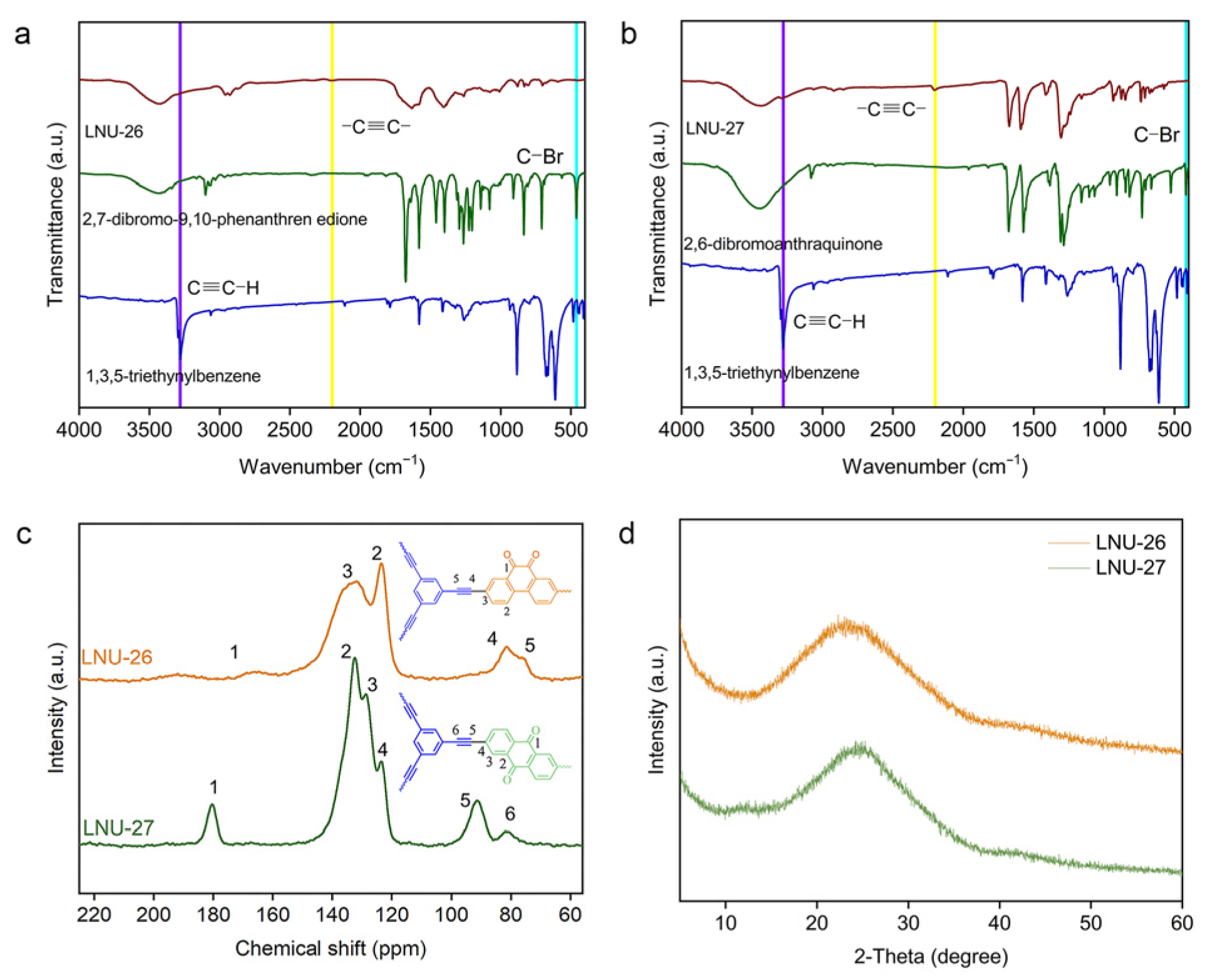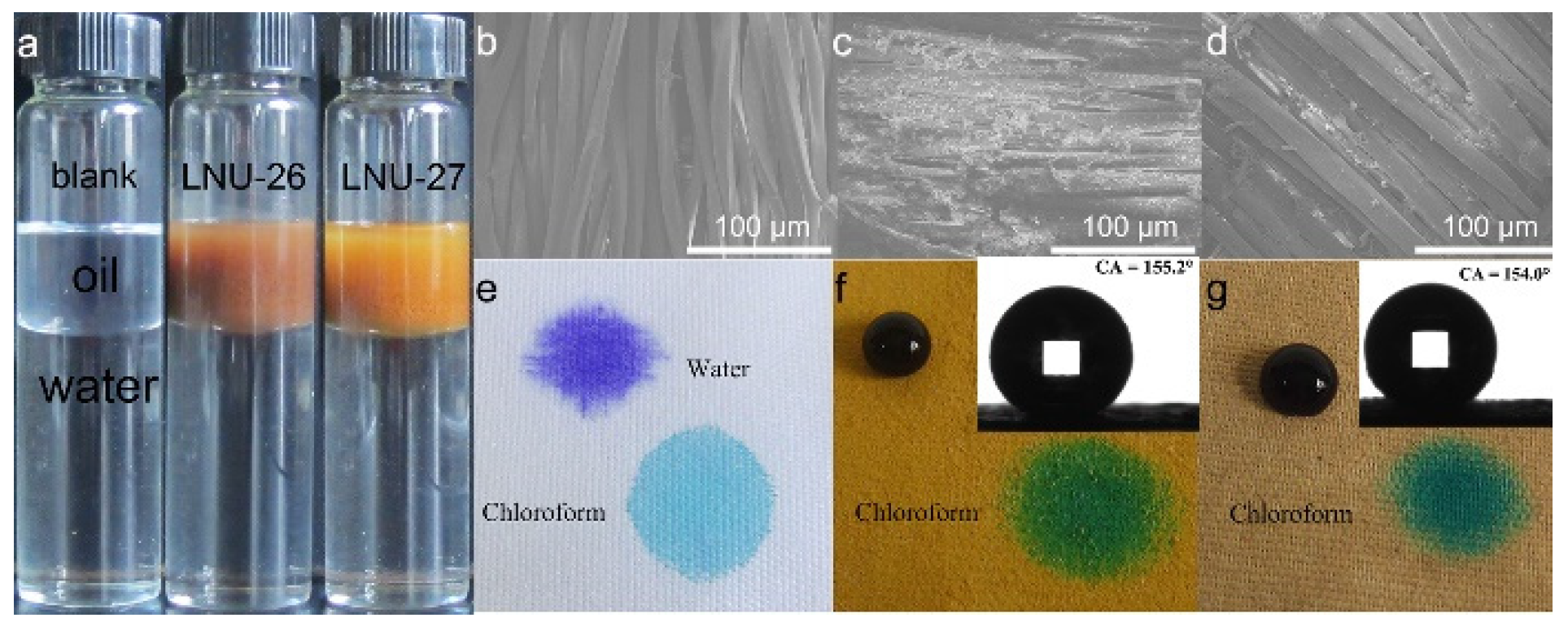Introducing Polar Groups in Porous Aromatic Framework for Achieving High Capacity of Organic Molecules and Enhanced Self-Cleaning Applications
Abstract
:1. Introduction
2. Results
3. Materials and Methods
3.1. Materials
3.2. Characterization
3.3. Synthesis of PAF Solids
3.4. Preparation of the Superhydrophobic Fabrics
3.5. Filtering Experiment
3.6. Preparation of the Self-Cleaning Glass Sheet
4. Conclusions
Supplementary Materials
Author Contributions
Funding
Institutional Review Board Statement
Informed Consent Statement
Data Availability Statement
Acknowledgments
Conflicts of Interest
Sample Availability
References
- Yang, C.; Kaipa, U.; Mather, Q.Z.; Wang, X.P.; Nesterov, V.; Venero, A.F.; Omary, M.A. Fluorous metal-organic frameworks with superior adsorption and hydrophobic properties toward oil spill cleanup and hydrocarbon storage. J. Am. Chem. Soc. 2011, 133, 18094–18097. [Google Scholar] [CrossRef] [PubMed]
- Yan, Z.J.; Qiao, Y.M.; Li, N.; Zheng, G.Y.; Cui, B.; Ruan, X.H.; Yang, Y.; Bu, N.S.; Yuan, Y.; Xia, L.X. Bio-inspired fabrication of porous aromatic framework-coated fabric for achieving durable superhydrophobic applications. Adv. Mater. Interfaces 2022, 9, 2101994. [Google Scholar] [CrossRef]
- Xu, L.; Zang, Y.; Xiao, J.J.; Wu, Y.F.; Pan, Y.X.; Wu, T.T.; Tang, Y.S.; Cui, J.; Jia, H.G.; Miao, F.J. Superhydrophobic conjugated microporous polymer-coated sponges: Synthesis and application for highly efficient oil/water separation and the recovery of palladium ions. Sep. Purif. Technol. 2021, 261, 118291–118302. [Google Scholar] [CrossRef]
- Hoang, A.T.; Nizetic, S.; Duong, X.Q.; Rowinski, L.; Nguyen, X.P. Advanced super-hydrophobic polymer-based porous absorbents for the treatment of oil-polluted water. Chemosphere 2021, 277, 130274–130305. [Google Scholar] [CrossRef] [PubMed]
- Coasne, B.; Alba-Simionesco, C.; Audonnet, F.; Dosseh, G.; Gubbins, K.E. Adsorption, structure and dynamics of benzene in ordered and disordered porous carbons. Phys. Chem. Chem. Phys. 2011, 13, 3748–3757. [Google Scholar] [CrossRef]
- Kalies, G.; Rockmann, R.; Tuma, D.; Gapke, J. Ordered mesoporous solids as model substances for liquid adsorption. Appl. Surf. Sci. 2010, 256, 5395–5398. [Google Scholar] [CrossRef]
- Zhao, H.T.; Nagy, K.L. Dodecyl sulfate-hydrotalcite nanocomposites for trapping chlorinated organic pollutants in water. J. Colloid Interface Sci. 2004, 274, 613–624. [Google Scholar] [CrossRef]
- Gui, X.C.; Wei, J.Q.; Wang, K.L.; Cao, A.Y.; Zhu, H.W.; Jia, Y.; Shu, Q.K.; Wu, D.H. Carbon nanotube sponges. Adv. Mater. 2010, 22, 617–621. [Google Scholar] [CrossRef]
- Long, R.Q.; Yang, R.T. Carbon nanotubes as superior sorbent for dioxin removal. J. Am. Chem. Soc. 2001, 123, 2058–2060. [Google Scholar] [CrossRef]
- Zhao, H.Y.; Jin, Z.; Su, H.M.; Zhang, J.L.; Yao, X.D.; Zhao, H.J.; Zhu, G.S. Target synthesis of a novel porous aromatic framework and its highly selective separation of CO2/CH4. Chem. Commun. 2013, 49, 2780–2782. [Google Scholar] [CrossRef] [Green Version]
- Zhao, Y.B.; Yuan, Y.; Xu, Y.M.; Zheng, G.Y.; Zhang, Q.; Jiang, Y.Q.; Wang, Z.Y.; Bu, N.S.; Xia, L.X.; Yan, Z.J. Fine-regulating ultramicropores in porous carbon via a self-sacrificial template route for high-performance supercapacitors. Nanoscale 2021, 13, 1961–1969. [Google Scholar] [CrossRef] [PubMed]
- Song, J.; Li, Y.; Cao, P.; Jing, X.F.; Faheem, M.; Matsuo, Y.; Zhu, Y.L.; Tian, Y.Y.; Wang, X.H.; Zhu, G.S. Synergic Catalysts of Polyoxometalate@Cationic Porous Aromatic Frameworks: Reciprocal Modulation of Both Capture and Conversion Materials. Adv. Mater. 2019, 31, 1902444–1902453. [Google Scholar] [CrossRef] [PubMed]
- Qiao, J.; Liu, L.; Shen, J.; Qi, L. Enzyme immobilization on a pH-responsive porous polymer membrane for enzymatic kinetics study. Chin. Chem. Lett. 2021, 32, 3195–3198. [Google Scholar] [CrossRef]
- Sun, Y.X.; Sun, Q.; Huang, H.L.; Aguila, B.; Niu, Z.; Perman, J.A.; Ma, S.Q. A molecular-level superhydrophobic external surface to improve the stability of metal–organic frameworks. J. Mater. Chem. A 2017, 5, 18770–18776. [Google Scholar] [CrossRef]
- Chen, Y.; Wang, L.; Kong, J.; Shen, B.; Xu, J. Superhydrophobic hierarchical porous divinylbenzene polymer for BTEX sensing and toluene/water selective detection. Chin. Chem. Lett. 2020, 31, 2125–2128. [Google Scholar] [CrossRef]
- Zhang, M.H.; Xin, X.L.; Xiao, Z.Y.; Wang, R.M.; Zhang, L.L.; Sun, D.F. A multi-aromatic hydrocarbon unit induced hydrophobic metal-organic framework for efficient C2/C1 hydrocarbon and oil/water separation. J. Mater. Chem A 2017, 5, 1168–1175. [Google Scholar] [CrossRef]
- Gao, W.; Li, M.; Fa, Y.; Zhao, Z.; Cai, Y.; Liang, X.; Yu, Y.; Jiang, G. Porous covalent organic frameworks-improved solid phase microextraction ambient mass spectrometry for ultrasensitive analysis of tetrabromobisphenol-A analogs. Chin. Chem. Lett. 2021, 33, 3849–3852. [Google Scholar] [CrossRef]
- Han, Z.-Y.; Li, H.-K.; Zhu, Q.-Q.; Yuan, R.; He, H. An intriguing electrochemical impedance aptasensor based on a porous organic framework supported silver nanoparticles for ultrasensitively detecting theophylline. Chin. Chem. Lett. 2021, 32, 2865–2868. [Google Scholar] [CrossRef]
- Wang, W.; Yuan, Y.; Sun, F.-X.; Zhu, G.-S. Targeted synthesis of novel porous aromatic frameworks with selective separation of CO2/CH4 and CO2/N2. Chin. Chem. Lett. 2014, 25, 1407–1410. [Google Scholar] [CrossRef]
- Cui, P.; Jing, X.-F.; Yuan, Y.; Zhu, G.-S. Synthesis of porous aromatic framework with Friedel—Crafts alkylation reaction for CO2 separation. Chin. Chem. Lett. 2016, 27, 1479–1484. [Google Scholar] [CrossRef]
- Jiang, Y.Z.; Liu, C.Y.; Li, Y.H.; Huang, A. Stainless-steel-net-supported superhydrophobic COF coating for oil/water separation. J. Membr. Sci. 2019, 587, 117177–117184. [Google Scholar] [CrossRef]
- Ge, M.Z.; Cao, C.Y.; Huang, J.Y.; Zhang, X.N.; Tang, Y.X.; Zhou, X.R.; Zhang, K.Q.; Chen, Z.; Lai, Y.K. Rational design of materials interface at nanoscale towards intelligent oil-water separation. Nanoscale Horiz. 2018, 3, 235–260. [Google Scholar] [CrossRef] [PubMed]
- Chen, C.L.; Weng, D.; Mahmood, A.; Chen, S.; Wang, J.D. Separation mechanism and construction of surfaces with special wettability for oil/water separation. ACS Appl. Mater. Interfaces 2019, 11, 11006–11027. [Google Scholar] [CrossRef] [PubMed]
- Zhang, Y.L.; Wei, S.; Liu, F.J.; Du, Y.C.; Liu, S.; Ji, Y.Y.; Yokoi, T.; Tatsumi, T.; Xiao, F.-S. Superhydrophobic nanoporous polymers as efficient adsorbents for organic compounds. Nano Today 2009, 4, 135–142. [Google Scholar] [CrossRef]
- Guo, J.W.; Yu, L.; Yue, H.B. Bulk fabrication of porous organic framework polymers on flexible nanofibers and their application for water purification. React. Funct. Polym. 2019, 135, 58–64. [Google Scholar] [CrossRef]
- Wei, H.J.; Wang, F.; Sun, H.X.; Zhu, Z.Q.; Xiao, C.H.; Liang, W.D.; Yang, B.P.; Chen, L.H.; Li, A. Benzotriazole-based conjugated microporouspolymers as efficient flame retardants with better thermal insulation properties. J. Mater. Chem. A 2018, 6, 8633–8642. [Google Scholar] [CrossRef]
- Pramoda, K.; Kumar, R.; Rao, C.N.R. Graphene/ single-walled carbon nanotube composites generated by covalent cross-linking. Chem. Asian J. 2015, 10, 2147–2152. [Google Scholar] [CrossRef]
- Lee, D.H.; Ko, K.C.; Ko, J.H.; Kang, S.Y.; Lee, S.M.; Kim, H.J.; Ko, Y.-J.; Lee, J.Y.; Son, S.U. In situ water-compatible polymer entrapment: A strategy for transferring superhydrophobic microporous organic polymers to water. ACS Macro Lett. 2018, 7, 651–655. [Google Scholar] [CrossRef]
- Wang, L.; Zhao, Y.; Tian, Y.; Jiang, L. A general strategy for the separation of immiscible organic liquids by manipulating the surface tensions of nanofibrous membranes. Angew. Chem. Int. Ed. 2015, 54, 14732–14737. [Google Scholar] [CrossRef]
- Cao, J.F.; Zuo, Y.J.; Zhang, J.; Feng, S.Y. Silicone-based materials synthesized via one-pot click reaction for selective adsorption of oils and water. Mater. Today Commun. 2020, 22, 100733–100740. [Google Scholar] [CrossRef]






Publisher’s Note: MDPI stays neutral with regard to jurisdictional claims in published maps and institutional affiliations. |
© 2022 by the authors. Licensee MDPI, Basel, Switzerland. This article is an open access article distributed under the terms and conditions of the Creative Commons Attribution (CC BY) license (https://creativecommons.org/licenses/by/4.0/).
Share and Cite
Yan, Z.; Qiao, Y.; Sun, Q.; Cui, B.; Feng, B.; Bu, N.; Chu, K.; Ruan, X.; Yuan, Y.; Yang, Y.; et al. Introducing Polar Groups in Porous Aromatic Framework for Achieving High Capacity of Organic Molecules and Enhanced Self-Cleaning Applications. Molecules 2022, 27, 6113. https://doi.org/10.3390/molecules27186113
Yan Z, Qiao Y, Sun Q, Cui B, Feng B, Bu N, Chu K, Ruan X, Yuan Y, Yang Y, et al. Introducing Polar Groups in Porous Aromatic Framework for Achieving High Capacity of Organic Molecules and Enhanced Self-Cleaning Applications. Molecules. 2022; 27(18):6113. https://doi.org/10.3390/molecules27186113
Chicago/Turabian StyleYan, Zhuojun, Yimin Qiao, Qiqi Sun, Bo Cui, Bin Feng, Naishun Bu, Kuo Chu, Xianghui Ruan, Ye Yuan, Yajie Yang, and et al. 2022. "Introducing Polar Groups in Porous Aromatic Framework for Achieving High Capacity of Organic Molecules and Enhanced Self-Cleaning Applications" Molecules 27, no. 18: 6113. https://doi.org/10.3390/molecules27186113
APA StyleYan, Z., Qiao, Y., Sun, Q., Cui, B., Feng, B., Bu, N., Chu, K., Ruan, X., Yuan, Y., Yang, Y., & Xia, L. (2022). Introducing Polar Groups in Porous Aromatic Framework for Achieving High Capacity of Organic Molecules and Enhanced Self-Cleaning Applications. Molecules, 27(18), 6113. https://doi.org/10.3390/molecules27186113







